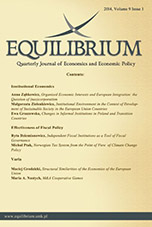Structural similarities of the economies of the European Union
Structural similarities of the economies of the European Union
Author(s): Maciej J. GrodzickiSubject(s): Economy
Published by: Instytut Badań Gospodarczych
Keywords: economic structure; structural convergence; European integration
Summary/Abstract: From the point of view of the consequences of European integration, similarities of economic structures of member states are of high relevance. The main objective of the paper is to analyse how those similarities looked like in the period of 1970-2006 for EU15 and in 1995-2006 for EU25 countries. The analysis consists of two stages and refers to the similarities in employment composition between three sectors of economy, and also between subsectors of manufacturing and services – distinguished on the basis of their technological advancement and knowledge intensity. In the first step, on the basis of the EU-KLEMS database, a measure of structural similarity, Krugman specialization index, was calculated for all pairs of EU countries. Observation of its values points to an ongoing homogenization of EU15 economies and of their manufacturing structures, but also to an increase in differences of knowledge intensity in services. In the broader sample of EU25, despite an ongoing economic transition, no significant homogenization of structures was observable. As the second step, a cluster analysis was conducted, which allowed for identification of development patterns in the sample of European countries.
Journal: Equilibrium. Quarterly Journal of Economics and Economic Policy
- Issue Year: 9/2014
- Issue No: 1
- Page Range: 93-117
- Page Count: 25
- Language: English

